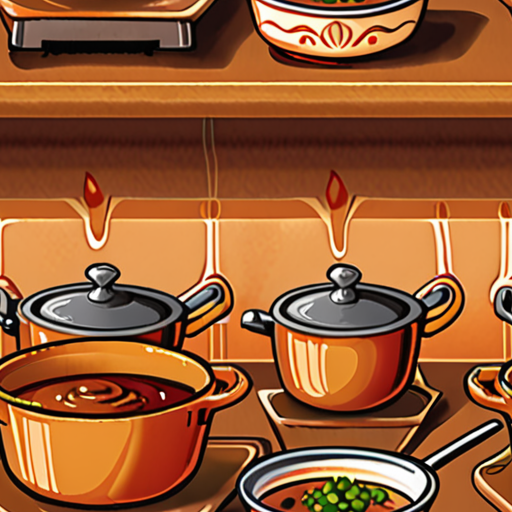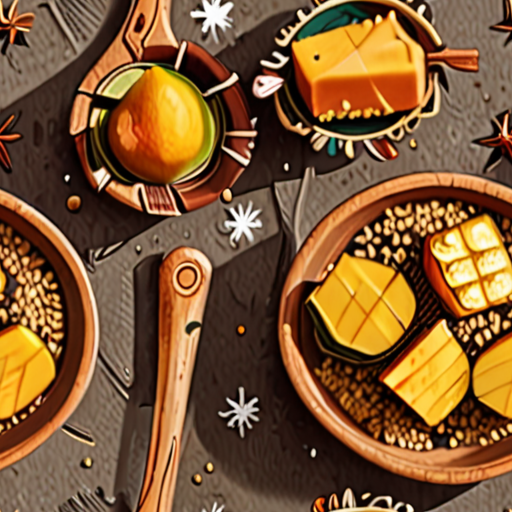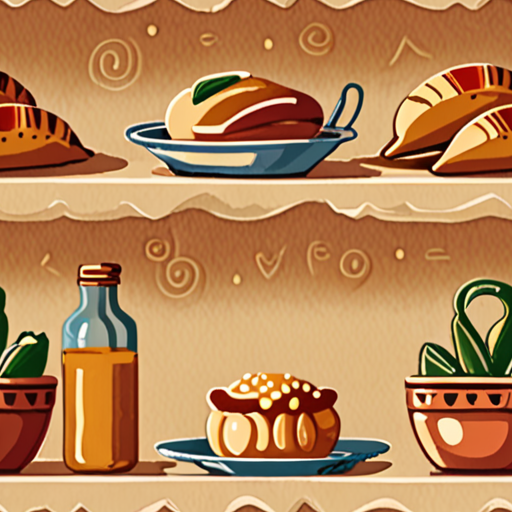For those who have ever ventured beyond the realm of traditional granulated sugar, baking with piloncillo has become a fascinating world of flavors and textures waiting to be explored. This traditional Mexican sugar substitute, known for its rich, caramel-like taste and versatility in both sweet and savory dishes, has been a staple in many Latin American households for centuries. With its unique characteristics and numerous applications, piloncillo has captured the hearts of home bakers and professional chefs alike, inspiring a new wave of creativity in the kitchen.

Baking with Piloncillo
Piloncillo is a type of unrefined cane sugar commonly used in Mexican baking, particularly in traditional desserts like moles and sweet breads.
- Melted piloncillo can be added to cookie dough and cake batters for a rich, caramel-like flavor.
- Grating piloncillo can be a bit tricky due to its hard, rock-solid texture.
- However, with the right tools and techniques, grating piloncillo can be done easily and efficiently.
Using Piloncillo in Baked Goods
Piloncillo adds a unique flavor and texture to baked goods, making it a popular choice among bakers.
- Cookies: Add melted piloncillo to cookie dough for a chewy, caramel-flavored treat.
- Cakes: Use grated piloncillo in cake batter for a moist, sweet dessert.
- Sweet breads: Piloncillo is a staple ingredient in traditional Mexican sweet breads, adding a rich, caramel flavor.
Tips for Working with Piloncillo
To make working with piloncillo easier, try the following:
- Use a microplane grater to grate piloncillo quickly and efficiently.
- Melt piloncillo in a double boiler or in the microwave to make it easier to work with.
- Store piloncillo in an airtight container to keep it fresh and prevent it from becoming too hard.
Can I Substitute Piloncillo for Brown Sugar in Baking?
Piloncillo is a type of unrefined cane sugar commonly used in Mexican desserts and drinks.
- Piloncillo has a rich, caramel-like flavor that is distinct from brown sugar.
- In many recipes, piloncillo can be substituted for brown sugar, although the flavor may vary slightly.
Key Considerations for Substituting Piloncillo for Brown Sugar:
- Flavor Profile: Piloncillo has a stronger, more intense flavor than brown sugar, which may affect the overall taste of your baked goods.
- Moisture Content: Piloncillo contains more moisture than brown sugar, which can impact the texture of your final product.
- Conversion Ratio: Generally, you can substitute piloncillo for brown sugar in a 1:1 ratio, but keep in mind that the flavor may differ.
When to Use Piloncillo Instead of Brown Sugar:
- Baked Goods with Strong Flavors: Piloncillo pairs well with bold flavors like cinnamon, nutmeg, and cloves, making it a great choice for spiced cakes and cookies.
- Mexican-Inspired Desserts: Piloncillo is a staple ingredient in traditional Mexican sweets like tres leches cake and churros.
Best Practices for Using Piloncillo in Baking:
- Start with Small Quantities: Begin by substituting a small amount of piloncillo for brown sugar to gauge the flavor and texture changes.
- Adjust Liquid Content: Since piloncillo contains more moisture than brown sugar, you may need to adjust the liquid content in your recipe accordingly.
- Experiment with Ratios: Find the perfect balance between piloncillo and brown sugar to suit your taste preferences.
Conclusion:
While piloncillo can be substituted for brown sugar in many recipes, it’s essential to consider the unique characteristics of each sugar and adjust your approach accordingly.

Can I Use Piloncillo Instead of White Sugar?
Piloncillo is a type of unrefined cane sugar commonly used in Latin American cuisine, particularly in Mexico.
- Piloncillo has a rich, caramel-like flavor and a coarse texture that sets it apart from refined white sugar.
- When substituting piloncillo for white sugar, keep in mind that it contains more moisture and has a stronger flavor profile.
Using Piloncilio in Baking
In baked goods, piloncillo can add a deep, molasses-like flavor and a hint of sweetness.
- To substitute piloncillo for white sugar in baking, start by reducing the amount of piloncillo called for in the recipe by about 25%.
- As you become more comfortable working with piloncillo, you can adjust the ratio to suit your taste preferences.
Benefits of Using Piloncillo
Piloncillo offers several benefits over refined white sugar:
- Higher mineral content: Piloncillo contains minerals like iron, magnesium, and potassium, which are often lost during the refining process.
- Lower glycemic index: Piloncillo has a lower glycemic index than white sugar, meaning it may cause a slower spike in blood sugar levels.
Tips for Working with Piloncillo
To get the most out of piloncillo, try the following:
- Grate or chop piloncillo before using it in recipes to release its full flavor potential.
- Store piloncillo in an airtight container to preserve its texture and flavor.

Difference Between Piloncillo and Brown Sugar
Piloncillo is a type of Mexican brown sugar made from pressed cane juice, whereas brown sugar is typically refined white sugar with added molasses.
- Piloncillo is boiled down to create a thick syrup, which removes excess water and caramelize the sugars slightly.
- Brown sugar, on the other hand, has varying levels of molasses added to give it a distinct flavor and color.
- Piloncillo is also known as Panela in Central and Latin America, highlighting its regional significance.
- The production process of piloncillo involves extracting the cane juice and boiling it down to create the final product.
- In contrast, brown sugar is often produced by adding molasses to refined white sugar.
When it comes to using these two types of sugar in cooking and baking, piloncillo adds a rich, caramel-like flavor, while brown sugar contributes a deeper, more robust taste.
For those looking to try piloncillo, it can be found in many specialty stores or online retailers, particularly those that cater to Mexican or Latin American cuisine.
At Panito Mole, we recommend experimenting with piloncillo in traditional Mexican desserts like Tres Leches Cake or Churros to experience its unique flavor profile.
Whether you’re a seasoned baker or just starting to explore the world of Mexican sweets, understanding the differences between piloncillo and brown sugar can elevate your creations and provide a deeper appreciation for the rich cultural heritage behind these ingredients.
Is Piloncillo Healthier Than Sugar?
Piloncillo, a type of unrefined cane sugar commonly used in Latin American cuisine, has gained popularity in recent years due to its perceived health benefits compared to refined sugar.
- Nutrient Content: Piloncillo contains minerals like iron, calcium, and potassium, which are often lacking in refined sugars.
- Lower Glycemic Index: Piloncillo has a lower glycemic index than refined sugar, meaning it may cause a slower increase in blood sugar levels.
- Antioxidant Properties: Some studies suggest that piloncillo contains antioxidants that can help protect against oxidative stress and inflammation.
However, it’s essential to note that piloncillo is still a form of sugar and should be consumed in moderation as part of a balanced diet.
- Comparison to Refined Sugar: While piloncillo may have some nutritional advantages over refined sugar, it is still high in calories and can contribute to weight gain and other health problems if consumed excessively.
- Impact on Digestion: Some individuals may experience digestive issues, such as bloating or gas, after consuming piloncillo due to its high fructose content.
- Availability and Cost: Piloncillo can be harder to find and more expensive than refined sugar, making it less accessible to some consumers.
In conclusion, while piloncillo may offer some potential health benefits compared to refined sugar, it is crucial to consume it responsibly and as part of a well-rounded diet.

Breaking Down Piloncillo
Piloncillo is a type of unrefined cane sugar commonly used in Mexican desserts and drinks.
- Method 1: To break down piloncillo, start by placing it on a cutting board and holding it firmly in place with one hand.
- With a sharp knife, carefully slice the piloncillo into thin pieces, applying gentle pressure to avoid crushing the sugar.
- Continue slicing until the piloncillo is broken down into small pieces, which can then be crushed further using a mortar and pestle or a spice grinder.
- Method 2: Alternatively, you can use a box grater or a vegetable peeler to grate or peel the piloncillo, respectively.
- This method is ideal for smaller quantities of piloncillo and produces a coarser texture than slicing.
- Once grated or peeled, the piloncillo can be crushed further using a mortar and pestle or a spice grinder.
When working with piloncillo, it’s essential to handle it gently to avoid generating heat, which can cause the sugar to become grainy or develop off-flavors.
To prevent this, work in a cool environment, and consider using a pastry brush or a silicone spatula to gently scrape the piloncillo into smaller pieces.
By breaking down piloncillo effectively, you’ll be able to incorporate it seamlessly into your favorite recipes, from traditional Mexican desserts to modern twists on classic treats.
Tips and Variations
- For a finer texture, crush the piloncillo in a spice grinder or coffee grinder before incorporating it into your recipe.
- To enhance the flavor of your piloncillo, try infusing it with spices or citrus zest before grinding or crushing it.
- Experiment with different types of piloncillo, such as brown or muscovado, to discover unique flavor profiles and textures.
Conclusion
Breaking down piloncillo may seem intimidating, but with the right tools and techniques, you’ll be able to unlock its full potential in your baking and cooking endeavors.
Whether you prefer the smooth texture of sliced piloncillo or the coarse texture of grated or peeled piloncillo, there’s a method to suit every need and preference.
So next time you’re working with piloncillo, remember to handle it gently, experiment with different techniques, and enjoy the rich flavors and aromas that this versatile ingredient has to offer.

0 Comments